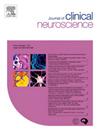Surgical resection of cerebellum cavernous malformation via suboccipital trans-horizontal fissure approach: Two-dimensional video
IF 1.8
4区 医学
Q3 CLINICAL NEUROLOGY
引用次数: 0
Abstract
Deep cerebellar cavernous malformations (CMs) pose considerable surgical challenges due to the difficulties in precise localization and achieving minimal invasive exposure during resection [1]. The horizontal fissure (HF), the largest cerebellar fissure, offers a natural cleavage plane to access deep cerebellar structures. This report details a successful deep medial cerebellar CM resection via a suboccipital Trans-HF approach. A 54-year-old male presented with dysarthria and gait instability, with a positive Romberg sign. Preoperative imaging revealed multiple suspected cerebellar CMs, with the largest hemorrhagic lesion situated deeply within the right cerebellum, adjacent to the dentate nucleus, surrounded by prominent developmental venous anomalies (DVAs). After discussion with the patient, microsurgical resection of the largest hemorrhagic CM was elected, informed consent was obtained and the procedure was approved by the ethics committee. Utilizing a prone, Concorde position, and a suboccipital midline craniotomy, the wide right suboccipital HF was identified and allowed for sharp and blunt dissection to enhance exposure [2,3]. Neuronavigation was employed, and the exposed DVAs served as anatomical landmarks to guide surgical trajectory toward the hidden lesion, minimizing parenchymal disruption [4]. Following the CM exposure, the hematoma inside was evacuated for decompression, and the CM was meticulously resected along its gliotic boundary, ensuring the preservation of adjacent DVAs, until complete removal was achieved. Pathological analysis confirmed the diagnosis of CM. Postoperative imaging demonstrated gross-total resection of the target CM with preserved DVAs. The patient exhibited significant symptomatic improvement. This case highlights the nuance of the suboccipital trans-HF approach for resecting deep medial cerebellar lesions.
经枕下横断入路小脑海绵状畸形手术切除:二维影像
深部小脑海绵状血管瘤(CMs)由于在切除[1]时难以精确定位和实现微创暴露,给手术带来了相当大的挑战。水平裂缝(HF)是最大的小脑裂缝,为进入小脑深部结构提供了一个天然的劈裂面。本报告详细介绍了通过枕下经hf入路成功切除小脑深部内侧CM。54岁男性,表现为构音障碍和步态不稳,Romberg征阳性。术前影像学显示多发疑似小脑CMs,最大的出血性病变位于右侧小脑深部,毗邻齿状核,周围有明显的发育性静脉异常(DVAs)。经与患者讨论,选择显微手术切除最大出血性CM,征得患者知情同意,并经伦理委员会批准。采用俯卧、协和位和枕下中线开颅术,识别右侧枕下HF,并允许进行尖锐和钝性解剖以增强暴露[2,3]。使用神经导航,暴露的dva作为解剖标志,引导手术轨迹到隐藏的病变,最大限度地减少实质破坏[4]。CM暴露后,将CM内的血肿抽离减压,并沿着其胶质边界仔细切除CM,确保保存邻近dva,直到完全切除。病理分析证实CM的诊断。术后影像学显示靶CM大体全切除,DVAs保存完好。患者表现出明显的症状改善。本病例强调了枕下经hf入路切除小脑深部病变的细微差别。
本文章由计算机程序翻译,如有差异,请以英文原文为准。
求助全文
约1分钟内获得全文
求助全文
来源期刊

Journal of Clinical Neuroscience
医学-临床神经学
CiteScore
4.50
自引率
0.00%
发文量
402
审稿时长
40 days
期刊介绍:
This International journal, Journal of Clinical Neuroscience, publishes articles on clinical neurosurgery and neurology and the related neurosciences such as neuro-pathology, neuro-radiology, neuro-ophthalmology and neuro-physiology.
The journal has a broad International perspective, and emphasises the advances occurring in Asia, the Pacific Rim region, Europe and North America. The Journal acts as a focus for publication of major clinical and laboratory research, as well as publishing solicited manuscripts on specific subjects from experts, case reports and other information of interest to clinicians working in the clinical neurosciences.
 求助内容:
求助内容: 应助结果提醒方式:
应助结果提醒方式:


